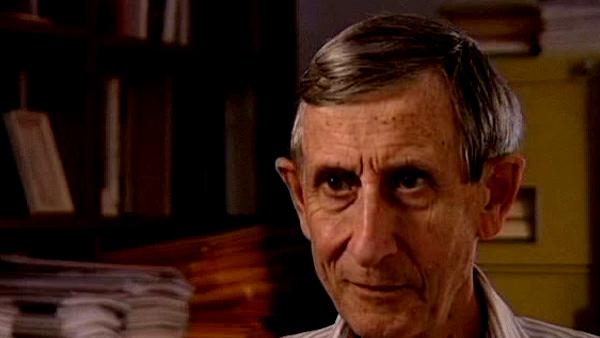NEXT STORY

Work on the strong interactions
RELATED STORIES

NEXT STORY

Work on the strong interactions
RELATED STORIES


|
Views | Duration | |
|---|---|---|---|
| 91. Gerry Brown | 1 | 1521 | 00:58 |
| 92. Attempts to make quantum electrodynamics into a completely... | 1 | 1922 | 04:31 |
| 93. Work on the strong interactions | 1506 | 03:17 | |
| 94. Fermi's rejection of our work | 1 | 3459 | 06:35 |
| 95. Why I don't like the PhD system | 3 | 4780 | 06:56 |
| 96. Being the laundry boy during the Oppenheimer security hearings | 1832 | 03:10 | |
| 97. Leave Princeton if Oppenheimer was sacked? | 1730 | 01:30 | |
| 98. Summer school at Les Houches | 2305 | 01:33 | |
| 99. Work at Berkeley with Charles Kittel | 2466 | 01:32 | |
| 100. Ferromagnetism and spin wave theory | 1611 | 05:06 |


This was a grand programme. I had the ambition of making quantum electrodynamics into a completely solvable theory, a theory in which one could calculate everything precisely, in which all the renormalisations would be done, out of the way, and you'd have a convergent series so that it was not just an asymptotic expansion but a real convergent series, so it would be a mathematically well-defined theory and everything could be done in principle as accurately as you want. So I sat down and tried to do that, and the tactic that I developed was to separate high and low frequencies, or high and low energies, so that you'd first of all systematically go through a power... series expansion in the high frequencies only, which would be convergent, and so therefore could be, in principle, calculated rigorously. And so once the high frequencies had been done all the renormalisations would be out of the way. The remainder of the problem would just be ordinary physics, the low frequencies which would not present any problems in principle; it would just be a matter then of hard work to find the solutions of things, like the hydrogen atom where you'd have to deal with the low frequencies numerically. So essentially the programme was to do the high frequencies analytically, and the low frequencies numerically. Well, it failed, and I put two years very hard work into it. It was a more concentrated period of hard work, in fact, than I ever did on anything else. I think I worked really with high concentration for about two years, which I've never really done on any other project that I was involved with. And I thought it would actually succeed. I published four papers in which various stages or the programme were gone through and it seemed to work well; from a formal point of view everything worked. I was able to reduce the Schrödinger equation and the Heisenberg operators into the form which I thought would make them convergent and so as far as the formalities were concerned, everything seemed to work. And so those were done. All that remained was actually to prove the convergence. And then, when I was in Switzerland in the summer of 1951, the moment of truth happened: I suddenly found a very simple argument which showed that the series are divergent anyway, and no matter what you do, whether you separate high and low frequencies or not, the perturbation series in quantum electrodynamics simply diverges, and the argument to show that is a simply physical argument which is published in a one page note in the Physical Review letters. So that was the end of the story and that particular illumination was in a way a very joyful time. I mean, because suddenly I had this burden lifted, that the programme was a failure, I didn't have to think about it any more; that chapter of my life was over. In a way I suddenly felt a sense of enormous relief, that I wasn't having to fight this monster any more, which had gone on for two years and it was obviously something that would remain beyond my reach, and that was it. So in a way it was a great success although it was also a failure. At least it showed that was a dead end but in the course of reaching the dead end I found out something about quantum field theory which was important, namely the fact that the perturbation theory really does diverge.
Freeman Dyson (1923-2020), who was born in England, moved to Cornell University after graduating from Cambridge University with a BA in Mathematics. He subsequently became a professor and worked on nuclear reactors, solid state physics, ferromagnetism, astrophysics and biology. He published several books and, among other honours, was awarded the Heineman Prize and the Royal Society's Hughes Medal.
Title: Attempts to make quantum electrodynamics into a completely solvable theory
Listeners: Sam Schweber
Silvan Sam Schweber is the Koret Professor of the History of Ideas and Professor of Physics at Brandeis University, and a Faculty Associate in the Department of the History of Science at Harvard University. He is the author of a history of the development of quantum electro mechanics, "QED and the men who made it", and has recently completed a biography of Hans Bethe and the history of nuclear weapons development, "In the Shadow of the Bomb: Oppenheimer, Bethe, and the Moral Responsibility of the Scientist" (Princeton University Press, 2000).
Tags: Schrödinger equation, Heisenberg operators, Switzerland, 1951, Physical Review
Duration: 4 minutes, 32 seconds
Date story recorded: June 1998
Date story went live: 24 January 2008